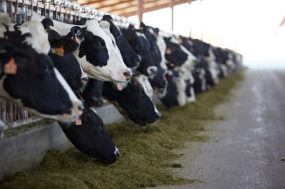Positive momentum will be key for the prosperity of the Canadian dairy industry, as it is approaching processing, innovation and policy challenges – compounded by the constant need to modernize facilities, systems and software – that will require integrated action from players across the industry.
At this year’s Progressive Dairy Operators (PDO) Symposium held in February, three experienced industry figures convened for the panel “Our industry: Risks of the status quo and ways to change and thrive” to address these obstacles and propose proactive strategies that would see the industry deviating from its status quo.
During the panel, which was moderated by Ontario dairy producer Ben Loewith, dairy industry veterans Peter Gould, Al Mussell and Mathieu Frigon pulled from their expertise to share insights into the pressing issues facing dairy producers, policymakers and processors alike.
Confronting aging infrastructure and concerns about processing capacity
Recent changes to SNF policy and pricing have shed light on the issue of aging infrastructure in the country’s processing facilities, a concern that was echoed by former General Manager of Dairy Farmers of Ontario Peter Gould. “Most of the dryers in the country are roughly 50 years old, inefficient and not made for products that make up much of those in demand in the market,” he explained. As existing facilities near the end of their operational lifespans, the urgency to modernize and increase processing capacity rises.
The bottleneck in processing and investment in processing facilities and capacity affects both the sector’s ability to meet consumer demand and the industry’s overall efficiency and competitiveness.
National solutions are needed to address this issue, Gould said, as he expressed critical views of the ability and willingness of provinces outside of Ontario to prioritize the needs of the sector on a national level and through a coordinated effort. “Planning is not a well-developed skill in some parts of the country,” he noted.
Trade dynamics and policy uncertainty
“There's such complexity to it,” Al Mussell, research director at the Canadian Agri-Food Policy Institute, said when discussing supply management’s role in understanding industry challenges. “We can't see – if you will – reform as an event; it has to be an ongoing process,” he continued. As a source of contention in nearly every trade agreement, Canada’s dairy sector must brace for continued rhetoric around access to Canadian dairy markets under supply management. With a U.S. election looming and possible upcoming change in Canadian federal leadership, trade dynamics and policy uncertainty will continue to shape the future of this country’s dairy industry.
“In terms of the substance of American trade policy, it has become protectionist, and both [Republican and Democratic] parties share that [philosophy]. There are really no political downsides – perceived ones anyway – in terms of throwing up barriers to trade,” Mussell explained. Understanding this stance is key to evolving Canada’s dairy strategy and safeguarding the interests of Canadian dairy stakeholders, particularly as the 2026 Canada-United States-Mexico Agreement (CUSMA) review approaches.
Risk assessment and the need for innovation
Mathieu Frigon, the president and CEO of the Dairy Processors Association of Canada, directly tackled the panel’s theme of status quo, as he called into question the risks of failing to deviate from the industry’s current conditions.
“Failing to assess the risk of the status quo does not mean that the risk won't materialize; it just means you won't be adequately prepared when it [arrives],” he warned. Citing a few examples of outdated legislation, like the omission of processors from several pieces of Canadian Dairy Commission policy, Frigon highlighted the need for continuous evaluation of policy decisions in line with evolving market conditions.
He urged stakeholders to question existing policies and practices to understand how they might be hindering innovation and competitiveness. “The risk of this type of status quo has materialized or is materializing,” Frigon concluded.
What now?
As the dairy sector evolves, each panelist underscored the importance of proactive planning, adaptability and strategic collaboration. Overcoming challenges like aging infrastructure, trade dynamics and regulatory constraints necessitates a multifaceted approach across provinces and among a variety of stakeholders.
“We've had a year of excellent achievements, but we have to ask: What now? The challenge is how to keep the ball rolling,” Mussell advised.










